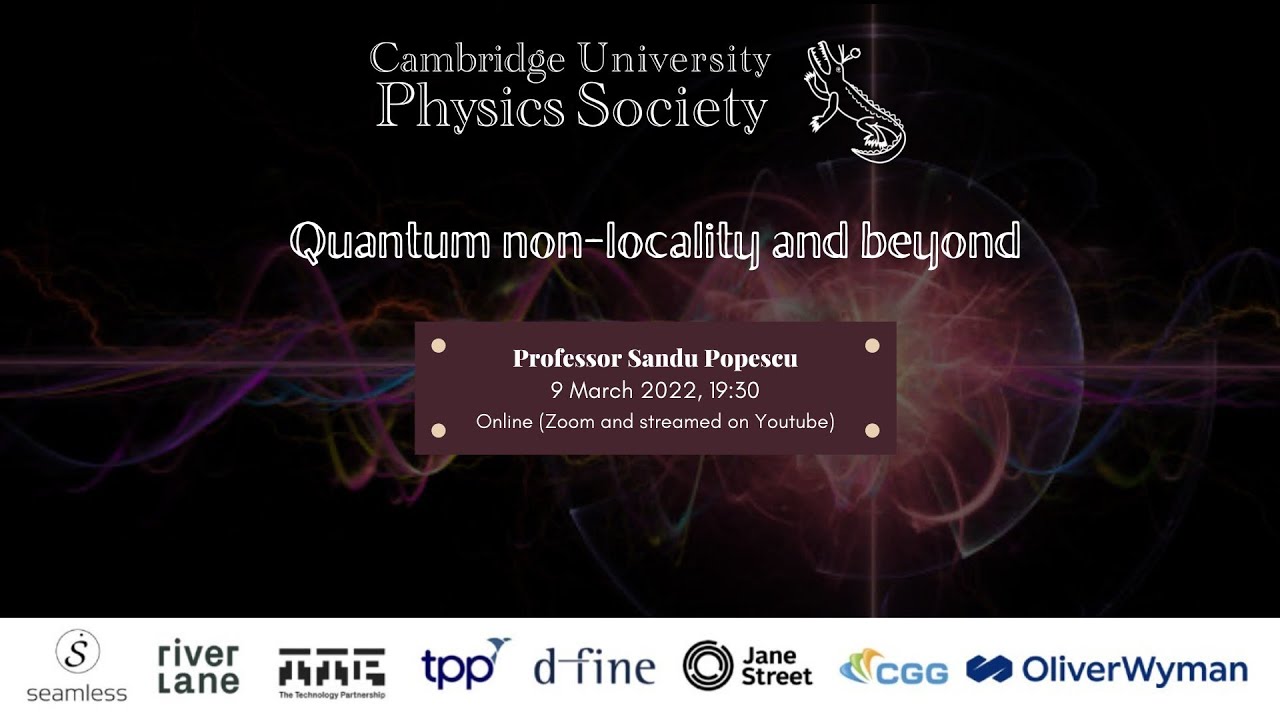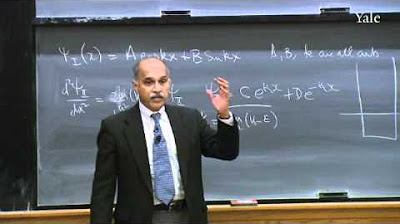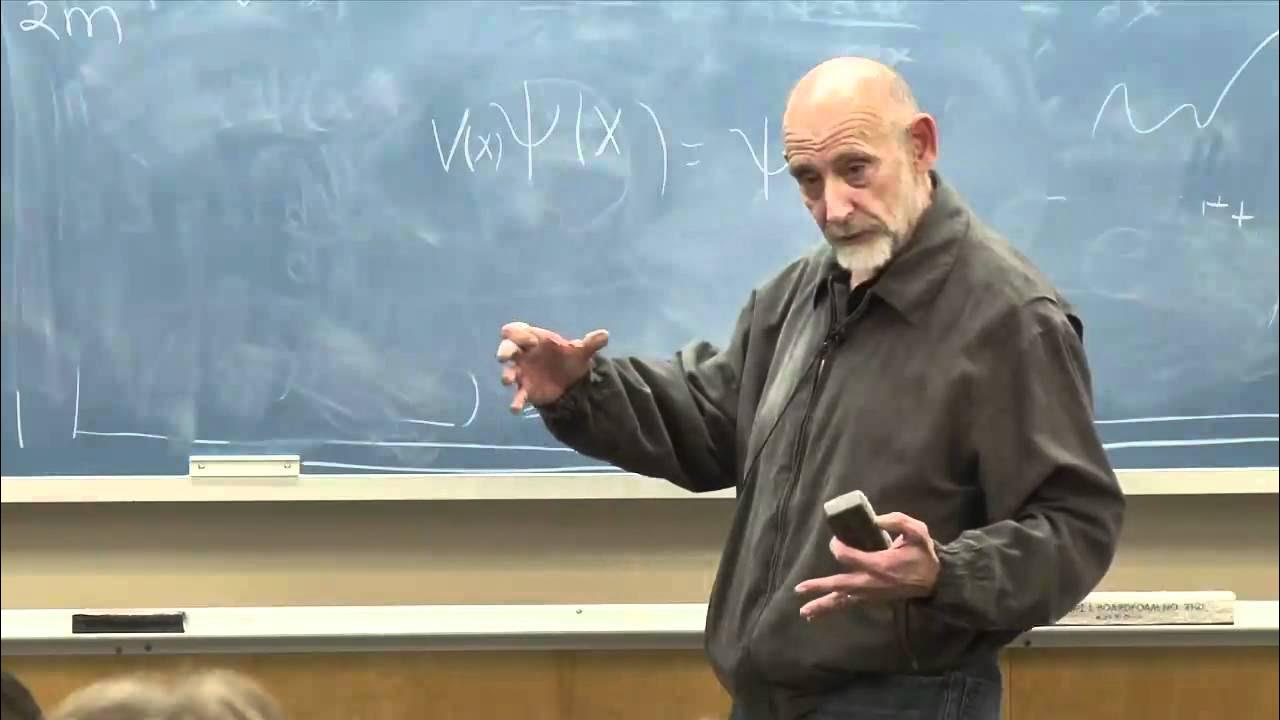Lecture 22: Metals, Insulators, and Semiconductors
TLDRThe lecture delves into the concept of crystal momentum, drawing parallels with traditional momentum and exploring its significance in the spatial variation of wave function phase. It also addresses the physical properties of materials like diamond and copper through band structure theory, elucidating why some materials are transparent and others conductive. The discussion highlights the EPR paradox, challenging our understanding of quantum mechanics and the concept of locality. The lecture concludes with an exploration of entanglement and its implications for quantum computation.
Takeaways
- 📚 The lecture discusses the physical significance of crystal momentum, its relation to the phase variation of the wave function, and its properties under the influence of external forces.
- 🌟 MIT OpenCourseWare is supported by donations and offers high-quality educational resources for free, with additional materials available on their website.
- 🔬 The professor uses the example of a wave function to explain how changing momentum can be achieved by modifying the phase of the wave function, highlighting the connection between spatial variation and momentum.
- 💡 The lecture explores the concept of momentum in quantum mechanics, including its definition, its role in the Heisenberg Uncertainty Principle, and its relation to the Ehrenfest Theorem.
- 🚀 The professor delves into the properties of crystal momentum in periodic potentials, explaining how it differs from regular momentum and its implications for the quantum behavior of particles in a lattice.
- 🔍 The discussion includes the impact of imperfections in a lattice on electrical conduction, emphasizing that a perfect lattice does not conduct electricity under an applied electromagnetic field.
- 🌐 The lecture touches on the theoretical and experimental aspects of quantum mechanics, including the challenges of creating perfect crystals and the effects of temperature and impurities on conduction.
- 🌌 The professor explains the band structure of materials, how it relates to their transparency and conductivity, and the concept of band gaps in insulators and conductors.
- 🚧 The lecture addresses the practical applications of band structure knowledge, such as in the creation of transistors and the understanding of material properties like transparency and conductivity.
- 🤔 The script raises philosophical questions about the nature of reality and locality in quantum mechanics, as exemplified by the EPR paradox and the concept of entanglement.
- 🎓 The lecture concludes with a historical note on Einstein's contributions to quantum mechanics, his philosophical struggles with its implications, and the aesthetic and intellectual challenges it presented to him.
Q & A
What is the physical significance of crystal momentum?
-Crystal momentum is a quantum mechanical property that governs the spatial variation of the phase of a wave function in a periodic potential. It is analogous to regular momentum but is defined in the context of a crystal lattice where the potential energy is periodic.
How is the crystal momentum related to the phase of the wave function?
-Crystal momentum is directly related to the spatial variation of the phase of the wave function. In a periodic potential, the crystal momentum (q) dictates how the phase of the wave function changes with position.
What is the difference between crystal momentum and regular momentum in the context of a periodic potential?
-While regular momentum is strictly conserved in the absence of an external force, crystal momentum is conserved modulo 2π/l, where l is the lattice spacing. This means that crystal momentum can effectively increase and decrease due to the periodic nature of the lattice, unlike regular momentum which only changes in the presence of a force.
How does the expectation value of momentum relate to the phase of the wave function?
-The expectation value of momentum can be understood in terms of the spatial variation of the phase of the wave function. A change in momentum corresponds to a change in the phase factor of the wave function, which in turn affects the expectation value.
What is the significance of the Ehrenfest Theorem in the context of this lecture?
-The Ehrenfest Theorem is significant because it connects the classical equation of motion to the quantum mechanical expectation values. It states that the time derivative of the expectation value of momentum is equal to the expectation value of the force, illustrating how classical mechanics emerge from quantum mechanics at the level of expectation values.
How does the presence of an external force affect the crystal momentum?
-An external force affects the crystal momentum by causing it to change over time. Unlike regular momentum, which is strictly conserved in the absence of a force, the crystal momentum can vary due to the periodic nature of the lattice, even when an external force is applied.
What is the role of the wave function's phase in the context of momentum and crystal momentum?
-The phase of the wave function encodes information about the momentum. Changes in the phase are associated with changes in momentum, and in the case of a periodic potential, the crystal momentum governs these phase changes.
Why are some crystals transparent while others are opaque?
-Crystals are transparent if they have a band gap that is larger than the energy of visible light, preventing electrons from being excited into states that would allow for the absorption of light. Opaque crystals either lack a band gap or have a smaller band gap that allows for the excitation of electrons by visible light.
What is a band insulator and how does it differ from a conductor?
-A band insulator is a material that has filled bands separated by a band gap from the next available band. It does not conduct electricity because there are no available states in the filled bands for electrons to move into. A conductor, on the other hand, has overlapping bands or a partially filled band that allows for the free movement of electrons.
What is the relevance of the EPR experiment in quantum mechanics?
-The EPR experiment, proposed by Einstein, Podolsky, and Rosen, is relevant because it highlights the paradox of quantum entanglement. It questions the completeness of quantum mechanics by demonstrating that measuring one particle instantly determines the state of another distant particle, seemingly violating the principles of locality and causality.
How does the concept of entanglement challenge our understanding of physical reality?
-Entanglement challenges our understanding of physical reality by showing that the state of one particle can instantly affect the state of another, regardless of the distance between them. This non-locality seems to contradict the principles of relativity and raises questions about the nature of reality and causality.
What is the significance of the band structure in determining the properties of materials?
-The band structure is significant in determining the properties of materials because it dictates whether a material can conduct electricity, is transparent, or is an insulator. The arrangement and overlap of bands, as well as the presence of band gaps, directly influence the material's response to electromagnetic radiation and the flow of electrons.
What is the role of temperature in semiconductors?
-In semiconductors, temperature plays a crucial role in determining their conductivity. At high temperatures, thermal fluctuations can excite electrons across the band gap, creating a population of free electrons and holes that can conduct electricity. At low temperatures, the probability of such excitations decreases, making the semiconductor more insulating.
What is the concept of a photonic crystal?
-A photonic crystal is a structure that exhibits a periodic variation in its dielectric constant, similar to how an atomic crystal has a periodic potential. Photonic crystals have bands of allowed and forbidden energies for light propagation, which can lead to unique optical properties such as transparency or reflection at specific wavelengths.
Outlines
📚 Introduction to MIT OpenCourseWare and Crystal Momentum
The script starts with a standard introduction to a lecture, highlighting the support for MIT OpenCourseWare and its mission to provide free educational resources. The professor then addresses the audience, mentioning a guest lecture at the end of the session and encourages questions from the audience. The first question posed by an audience member is about the physical significance of crystal momentum, which the professor agrees to explain, setting the stage for a detailed discussion on the topic.
🌟 Exploring the Concept of Crystal Momentum
The professor delves into the concept of crystal momentum, starting with a discussion on the physical meaning of momentum in general. He uses the example of a wave function to illustrate how momentum can be altered and relates this to the phase variation of the wave function. The lecture then transitions into the specifics of crystal momentum, explaining its role in governing the spatial phase variation within a periodic potential. The professor also touches on the conservation of crystal momentum, its time independence, and its distinction from regular momentum due to its lack of being an eigenvalue of the momentum operator.
🔬 The Properties and Conservation of Crystal Momentum
Continuing the discussion, the professor explains the properties of crystal momentum, emphasizing its conservation modulo 2π/l, where l is the lattice spacing. This unique periodicity is contrasted with the strict conservation of regular momentum. The lecture also explores the implications of an external force on crystal momentum and how it changes according to the conservation law, highlighting the periodic nature of this change. The professor concludes this section by encouraging students to develop an intuition for crystal momentum through examples, particularly in the context of solid-state physics.
🔍 The Role of Translational Symmetry in Quantum Mechanics
The script explores the implications of translational symmetry in quantum mechanics, particularly in the context of eigenfunctions and the impact of a periodic potential. The professor discusses how the eigenfunctions of the translation operator can be constructed and how they relate to the phase of the wave function. The lecture also addresses the subtleties of defining real functions in the presence of translational symmetry and the consequences for the current in quantum systems, leading to a deeper understanding of quantum behavior in periodic potentials.
🌐 The Impact of Periodic Potentials on Energy and Momentum
This section delves into the effects of periodic potentials on energy and momentum in quantum systems. The professor explains how the introduction of a periodic potential can lead to the formation of energy bands and the concept of Bloch oscillations. The lecture also discusses the experimental verification of these theoretical predictions, including the use of optical lattices to simulate quantum systems and observe the expected behavior. The professor emphasizes the importance of understanding the relationship between theory and experiment in quantum mechanics.
💡 Understanding the Quantum Behavior of Particles in a Lattice
The script examines the behavior of particles in a lattice, focusing on the quantum mechanical description of electrons in a periodic potential. The professor discusses the conditions under which current can flow in such a system, highlighting the role of superpositions and energy gaps between bands. The lecture also touches on the transparency and conductivity properties of materials, providing insights into the quantum origins of these macroscopic properties.
🚀 The Quantum Mechanics of Conduction and Valence Bands
This part of the script discusses the quantum mechanical basis for electrical conductivity and the role of conduction and valence bands. The professor explains how the filling of these bands determines the electrical properties of materials, leading to the classification of materials as conductors, insulators, or semiconductors. The lecture also explores the concept of band gaps and their significance in the transparency and electrical behavior of materials like diamond and copper.
🌌 The Complexity of Three-Dimensional Band Structures
The script moves into a detailed discussion of band structures in three dimensions, highlighting the complexity introduced by the additional degrees of freedom. The professor explains how the interaction between different energy states can lead to overlapping bands and the potential for current flow even in the presence of a filled band. The lecture also touches on the concept of semiconductors and the role of temperature in their conductivity, providing a deeper understanding of the quantum mechanical underpinnings of material properties.
🔬 The Quantum Mechanics of Semiconductors and Their Properties
This section delves into the properties of semiconductors, focusing on the quantum mechanical explanation for their behavior. The professor discusses how the small band gaps in semiconductors allow for thermal excitation of electrons, leading to conductivity at higher temperatures. The lecture also explores the quantum mechanical description of the EPR paradox, introducing the concept of entanglement and its implications for our understanding of physical reality.
🤔 The EPR Paradox and the Foundations of Quantum Mechanics
The script concludes with a discussion of the EPR paradox, a thought experiment proposed by Einstein, Podolsky, and Rosen to challenge the completeness of quantum mechanics. The professor summarizes the paradox, which involves the seemingly instantaneous correlation between the states of two entangled particles, and its implications for the principles of locality and reality in physics. The lecture also touches on the historical context and the subsequent debates surrounding the interpretation of quantum mechanics.
Mindmap
Keywords
💡Crystal Momentum
💡Momentum
💡Ehrenfest Theorem
💡Wave Function
💡Energy Bands
💡Periodic Potential
💡Quantum Mechanics
💡Schrodinger Equation
💡Band Gap
💡EPR Paradox
💡Entanglement
Highlights
The significance of crystal momentum in relation to the spatial variation of the wave function's phase is discussed.
Momentum is defined not only by its commutation relations but also by its role in governing the wave function's phase variation.
The Ehrenfest Theorem is highlighted, emphasizing the relationship between momentum, potential, and force in quantum mechanics.
Crystal momentum is distinguished from regular momentum by its role in periodic potentials and its conservation properties.
The physical interpretation of the wave function's phase and its relation to momentum is explored.
The impact of external forces on crystal momentum and its conservation is discussed.
The difference between crystal momentum and regular momentum in terms of eigenvalue properties is clarified.
The role of periodicity in the definition and properties of crystal momentum is explained.
The concept of Bloch's theorem and its implications for wave functions in periodic potentials are introduced.
The physical significance of the expectation values of position and momentum in quantum systems is discussed.
The relationship between the spatial variation of the wave function and the current in a system is explored.
The importance of the choice of variables in quantum mechanics and its impact on the description of systems is highlighted.
The effects of imperfections and impurities in a lattice on electrical conduction are examined.
The distinction between free particle behavior and that of a particle in a periodic potential is made clear.
The concept of band structure in solids and its relation to the properties of materials is introduced.
The role of the band gap in determining the transparency and conductivity of materials is explained.
The historical context and implications of the EPR experiment and Einstein's views on quantum mechanics are discussed.
The aesthetic and intellectual challenges that quantum mechanics presents to physicists, including Einstein, are highlighted.
The importance of the photoelectric effect in the development of quantum theory and Einstein's contribution is noted.
Transcripts
Browse More Related Video
5.0 / 5 (0 votes)
Thanks for rating:





